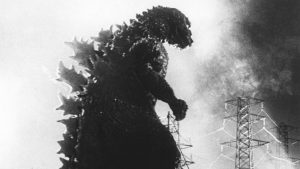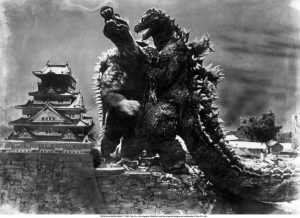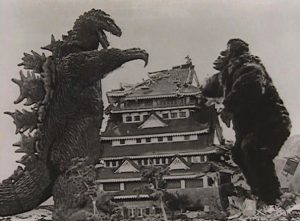Nothing quite screams awesome like Godzilla. Synonymous with Japanese monster movies, Godzilla has been stomping on cities for over sixty years. With the MonsterVerse beginning to grow, we will be taking a look back at how far the series has come. How? By watching and reviewing every single Godzilla movie. And, that does include the American features as well. Each review will be short and to-the-point, with some exceptions. This first article will deal with the first part of the “Showa” era, from 1954 to 1968. For clarity’s sake, we will be watching the American dubbed versions of the Japanese films, save the original.
Godzilla (1954)
Long before he was a heroic mediator for nature, or a children’s friend, Godzilla was an embodiment of nuclear warfare. The film was released in 1954, a mere decade after the bombings of Hiroshima and Nagasaki. Godzilla serves to personify and warn about the horrors of the atomic bomb. Before the franchise became cheesy, the 1954 film was a serious, depressing disaster film. Many American disaster films took inspiration from this film, occasionally having similar messages (e.g. The Day After Tomorrow).
Godzilla himself is obviously an actor in a rubber suit. Godzilla was performed by Haruo Nakajima and Katsumi Tezuka, though their experiences in the suit were notoriously harsh. Many traits of the franchise are established here – Godzilla wrecking cities, scientists explaining things, and the military failing miserably to stop Godzilla.
Being made by people who experienced nuclear destruction first hand, the film’s tone is bleak and depressing. The gritty cinematography, and use of models and war footage really helps set the mood. There are disturbing scenes of people dying in hospitals, a haunting choir of school girls singing, and we even see Tokyo’s emergency services in action against Godzilla’s sea of fire. Admittedly the film does reuse footage throughout, but it’s not an issue.
The film also expresses the themes of misusing science. The main character, Dr. Serizawa, has invented the Oxygen Destroyer, which, as its name suggests, can neutralise oxygen in an aquatic environment. However, he fears its use could turn it into a weapon of mass destruction, plotting to destroy his research if exposed.
The American version of the film was titled “Godzilla, King of the Monsters”, and starred Raymond Burr, who acted as a new point of view for the film. However, most of the footage involved Burr basically describing things to the audience. This would be an ongoing irritation in the series. Still, it was the only version that American audiences had access to, until the original uncut version was released in 2004.
Godzilla Raids Again (1955)
Godzilla’s sequel, Godzilla Raids Again, is to be frank, a bit of a letdown. Gone is the grim tone, and instead we have a rather goofy atmosphere. The film has an abundance of stock footage in it, even using footage from the first film. In the dub, Godzilla is called “Gigantis”. Why change the name a year after the dub of the 1954 was released? Apparently this was done so audiences didn’t mistake the new Godzilla for the first one. The main character, pilot Shoichi Tsukioka, doubles as the film’s rather grating narrator. We don’t need you to explain everything that is happening onscreen, when we can see it ourselves! The only major thing of interest in the film is the introduction of Anguirus, an Ankylosaurus-like monster, who is Godzilla’s rival/best friend. The two monsters kick each other’s asses throughout the film. Also, it is never really explained if this is a different Godzilla, or the same one from the first movie.
King Kong vs. Godzilla (1962)
Before Batman v. Superman, there was King Kong vs. Godzilla. The ultimate monster mash, the film is certainly great fun. Initially, the film was actually going to involve Kong fighting Frankenstein’s Monster. But, with Toho interested in reviving Godzilla, they decided to have him take on America’s favourite ape. Still, there is tribute to the original idea, with Kong getting struck by lightning and growing larger. The film also pays tribute to Kong’s 1933 classic. He kidnaps a woman at one point, and climbs up a high building whilst under attack by planes.
With Kong, the story is very light-hearted and silly, but when Godzilla is around, it is serious in tone. The owner of a Japanese pharmaceutical company sends two of his employees to Kong’s island to confirm his existence, planning to use the ape to promote his products. I guess this was before Japan developed their “kawaii” culture, and made mascots for everything. There’s a rather surreal moment when an actual octopus, posed as a Kaiju, attacks Kong’s worshippers. The military lull Kong to sleep, and then airlift him to Mount Fuji to destroy Godzilla.
There are actually two fights between the monsters, but the second one is more memorable. Godzilla mostly kicks Kong to the curb, but Kong gets struck by lightning, and can now generate electricity. Kong has a great moment when he tries shoving a tree down Godzilla’s throat. For years, there was a rumour that the film had two endings where both monsters won. Well, I can assure you that the film only has one ending, if an ambiguous one.
Mothra vs. Godzilla (1964)
While King Kong vs. Godzilla is considered the lone crossover in the Godzilla films, it is actually just the first. Mothra vs. Godzilla was the first encounter between two Japanese Kaiju. The titular Mothra had starred in her own film in 1961, and would become a permanent fixture in the franchise. Unlike Godzilla, Mothra is a nature goddess, often benevolent and peaceful. But, she is still a major threat, even if she is a gigantic moth.
The plot is straightforward and fun. Mothra’s egg washes up in a Japanese resort, and a douchebag businessman wishes to turn it into a tourist attraction. A scientist, a news reporter, and his plucky photographer team up with Mothra’s two fairy guardians (just roll with it), to make sure the egg returns to Mothra’s island. Why the two magic fairies, or Mothra, can’t simply transport it back themselves is never brought up. Godzilla shows up about half an hour in, coming out of the ground for some reason. The usual film shenanigans follow, Godzilla goes on a rampage, people flee, the military are useless. You know the drill!
The human characters are quite stereotypical, though it is neat to have a human villain in the series. While the military plot to use an electrical net to stop Godzilla, our heroes travel to Mothra’s island to recruit Mothra’s help. I’m certain the natives are the same ones that worship King Kong. Oddly, Mothra is referred to as “The Thing” in the English dub. There are some great moments in the film, particularly involving the birth of Mothra’s offspring, and how they stand up to Godzilla. By far, this is one of the best Godzilla films.
Ghidorah, the Three-Headed Monster (1964)
The fifth installment of the franchise introduced Godzilla’s arch nemesis, King Ghidorah, a space-faring, three-headed dragon that can shoot lightning. The film also introduced Rodan, a gigantic pterosaur, who had first starred in his own film in 1956. The film’s story is all over the place, yet quite entertaining. When Ghidorah threatens Earth, a formless entity possesses a princess and claims to be a Martian. Huh? She suggests that Godzilla, Rodan, and the surviving Mothra infant should join forces to defeat Ghidorah. The human story outside of the princess is uninteresting. This premise appears to be the inspiration for the upcoming Godzilla: King of the Monsters.
The comedy starts to become more prominent in the film. Godzilla and Rodan practically spend their whole time fighting each other. By the time Mothra arrives, the two are having a volley ball match with rocks. There’s also an extensive bit where Mothra’s two fairies show up in a Japanese variety TV show as celebrities. They end up playing a significant role in the story, acting as translators when the Kaiju all meet up. The last few minutes are pretty awesome, with Godzilla, Mothra, Rodan, and Ghidorah all fighting.
Invasion of the Astro-Monster (1965)
The sixth film went by several names including “Monster Zero”. Though the last film somewhat established aliens to the lore, Invasion of the Astro-Monster cemented it. The mysterious Planet X appears in the Solar System. Japanese and American pilots fly to the planet, meeting the weird locals who live underground in fear of Ghidorah. The aliens, the Xiliens, ask Earth to “lend” them Godzilla and Rodan to kick Ghidorah’s ass. But, surprise, surprise, the aliens turn out to be evil and want control of Earth, or they will unleash the brainwashed Kaiju upon mankind.
It’s definitely interesting seeing aliens appearing in the franchise, even if they look like Daft Punk groupies. The film creates a sophisticated, detailed culture and lifestyle for the Xiliens, explaining their ways of life, marriage, and gender roles. It’s a little weird to see an American actor in the lead role, when all of the Japanese actors have been dubbed over. Of course, we’re all here for the monster action, and there are several fights throughout the film. The best moment of the movie has to be when Godzilla does a weird victory dance after the first battle against Ghidorah (as seen above).
Ebirah, Horror of the Deep (1966)
Ebirah, Horror of the Deep, also known as “Godzilla vs. The Sea Monster”, does away with the traditions of Godzilla and goes in a new direction. Almost like a James Bond parody, the film involves a secret island where a terrorist group are making nuclear bombs. Heck, the soundtrack sounds a little Bond-ish at times too. The plot hits the ground running. Four blokes end up stranded on a remote island after getting lost at sea, thanks to the machinations of one of them looking for his missing brother. They soon discover the terrorists, the Red Bamboo, have enslaved Mothra’s worshippers to make their weapons. And if anyone tries to escape, they will be chased down and eaten by a giant lobster named Ebirah. It’s a pretty cool monster, the mix of special effects and a large water tank making it look quite menacing. Very Gerry Anderson in quality.
Godzilla doesn’t show up until half way through, found asleep in a cave. They decide to wake him up by using a sword as a lightning rod. Perhaps another allusion to Frankenstein? Godzilla is soon stomping around, doing what he does best. There is an interesting scene where Godzilla corners a native woman and seems to just stare at her for a long time, before randomly falling asleep. This may be a nod to the fact this was originally going to be a King Kong film. Probably the worst part of the film is when a giant condor shows up for no reason and fights Godzilla. The problem is that the fight is edited with rapidly changing, close up shots, so you can’t tell what is going on. Mothra also makes an appearance, but only in the last seven minutes! Most notably, this is the first film to depict Godzilla as a hero.
Son of Godzilla (1967)
Son of Godzilla is an important milestone in Godzilla’s history – he became a father. In the film, we meet his son Minilla, a cute but somewhat inept Kaiju. How Godzilla can breed is a mystery. Is he asexual like his TriStar counterpart? Son of Godzilla has a lot of heart to it, and even manages to balance out the subplots between the humans and monsters well. There is a lot going on in the film, but kept me engaged all the way through. An eccentric journalist parachutes onto Monster Island, joining a small team of scientists to study the monsters, and perform weather-altering experiments. However, Godzilla’s untimely arrival causes the climate to go haywire, cutting the team off from the outside world. I enjoy the focus on isolation and fear in a hostile environment, with the men slowly going mad.
The local monsters are also pretty menacing. There’s a swarm of giant mantises named Kamacuras (or Gimantis), and the giant spider, Kumonga. The puppetry and costumes work particularly well with the arachnid, who serves as the main antagonist. Anyway, the highlight of the film has to be the relationship between Godzilla and his new son. Minilla is a bit of a pushover, struggles to follow in his dad’s footsteps, but keeps trying anyway.
Godzilla is quite rough on his son, threatening to wallop him one if he doesn’t try roaring or firing an atomic blast. However, he seems to warm up to his kid. It’s probably one of the few times Godzilla shows some compassion, and learns to be a good father. The best moment is at the end of the movie. The scientists use a device to create a snowstorm on the island. Godzilla and Minilla navigate their way through the snow, and both end up embracing each other to survive it. Some people say that this is one of the worst films in the franchise, but I disagree. Minilla isn’t the most interesting of monsters, but his relationship with Godzilla is really sweet, and the movie has plenty of charm.
Destroy All Monsters (1968)
By 1968, Godzilla’s popularity was waning. So, Toho decided to end the King of Monsters’ reign in style. Destroy All Monsters has the biggest monster mash in cinematic history, bringing together all of Toho’s Kaiju for a big brawl. Or at least in the last twenty minutes of the film. We have jumped some time ahead in the timeline, now in 1999, so this would be the end point in the first continuity. That’ll become confusing down the line, believe me!
A bunch of subterranean aliens, who are dressed like figure skaters, plot to build a new scientific civilization on Earth at the cost of humanity. They capture the various Kaiju and control them to trash some major cities. While mankind run around and do the boring stuff, it’s the Kaiju that carry the film. Godzilla, Minilla, Mothra, Rodan, Anguirus, the Gorosaurus (who debuted in King Kong Escapes), and Kumonga team up to fight King Ghidorah. Varan, Manda, and Baragon, other monsters from Toho’s catalogue, all make cameos. The battle is great fun, but is probably the singular highlight from the film.
What are your thoughts on Godzilla’s early days? Which is your favourite film? Leave a comment below, or on our Twitter feed.











